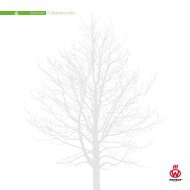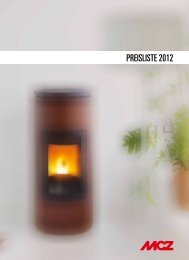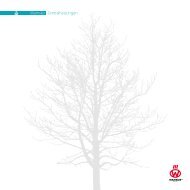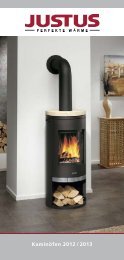Feuerstellen Exklusiv.pdf - Kleining
Feuerstellen Exklusiv.pdf - Kleining
Feuerstellen Exklusiv.pdf - Kleining
Erfolgreiche ePaper selbst erstellen
Machen Sie aus Ihren PDF Publikationen ein blätterbares Flipbook mit unserer einzigartigen Google optimierten e-Paper Software.
General Information – Regulations – Chimney – Fuel types<br />
With this brochure, we would like not only to acquaint you with<br />
our wide heating equipment product range but also to give you<br />
some advice concerning its functioning, use, and maintenance.<br />
We will begin by providing some general information. You will<br />
find more specific hints and information regarding requirements<br />
and regulations in the descriptions found in the product-specific<br />
sections (chimney stoves, cookers, pellet stoves, etc.).<br />
CO2 neutral – renewable energies<br />
Sonnenlicht<br />
CO2<br />
O2<br />
CO2<br />
Mineralstoffe<br />
Wasser<br />
(H 2<br />
O)<br />
H 2<br />
O<br />
Asche<br />
H 2<br />
O<br />
Verluste<br />
Nutzwärme<br />
(Sonnenlicht = sunlight; Wasser = water; Asche = ashes; Mineralstoffe = mineral<br />
compounds; Verluste = loss; Nutzwärme = usable heat)<br />
Next to the proverbial coziness of heating with wood, one central<br />
argument in its favour is the positive effect it has on the<br />
environment. Heating with wood means using renewable fuels.<br />
It is called ‘neutral regarding CO2’ since burning wood or letting<br />
it rot in the forest frees only the amount of carbon dioxide (CO2)<br />
that was stored by the tree during growth by means of photosynthesis.<br />
Trees absorb solar energy, water, and CO2 and emit<br />
oxygen and water vapor. They transform water from the ground<br />
and carbon dioxide from the air. Sulphur dioxides, by the way,<br />
are of no importance in this process, unlike the role they play in<br />
the burning of oil and coal.<br />
The Stuttgart, Regensburg,<br />
and Munich BStV – 15 aB-VG (Austria)<br />
Due to their location, some communities have the right to issue<br />
their own regulations concerning fuel use. Some of these regulations<br />
include requirements applying to the flue gas specifications<br />
of those fireplaces whose emissions exceed the standard<br />
EN norms. Regarding this aspect, the limits have been set especially<br />
low. The CO content of the flue gases at nominal heat output<br />
and under the test conditions stipulated by the relevant EN<br />
norms is not permitted to exceed specifically set limits. The fireplaces<br />
produced by our company are in complete accordance<br />
with all standard stipulations and regulations.<br />
BImSchV<br />
The BImSchV stipulates more exacting requirements for fireplaces<br />
regarding respirable dust, degree of efficiency, and CO<br />
immission. All fireplaces presented in this brochure are in full<br />
accordance with the currently valid statutory requirements as<br />
defined by the BImSchV and may continue to be used in the future<br />
without the need to install a respirable dust filter.<br />
About the chimney<br />
To make sure a chimney’s draft is strong enough, it must have a<br />
sufficient effective height and a sufficient and unobstructed crosssectional<br />
area. The necessary dimensions depend on the type and<br />
output of the fireplace, and the exact calculations must be made<br />
according to DIN EN 13884. Suppliers of system chimneys will<br />
make these calculations for you, and the locally responsible chimneysweep<br />
is a competent partner who will help you with this.<br />
HINT: The chimney should have a height of at least four<br />
meters, measured from the fireplace connection.<br />
In addition to this, experts warn against the use of obsolete,<br />
single-layer chimneys: in most instances, these cannot be used<br />
with modern, low-temperature flue gas fireplaces. The same applies<br />
in the vast majority of cases to pellet stoves. The main argument<br />
against the use of such a chimney is safety: after a soot<br />
fire, cracks appear in the chimney wall. Also, single-layer chimneys<br />
are prone to condensation: the flue gases move upwards<br />
more slowly, cool down sooner and condense – the result is<br />
condensation of the chimney. The chimney walls corrode, and a<br />
black liquid emits from the service door or the pipe in the cellar.<br />
Fuel types<br />
In domestic and manually fed fireplaces made by <strong>Kleining</strong>, only<br />
dry wood in its natural state and, in some cases, lignite briquettes<br />
may be used, in accordance with the First Regulation regarding<br />
the Implementation of the Federal Immission Protection<br />
Law (1. BImSchV).<br />
Burning wood<br />
Only dry wood with a maximum water content below 20 % may<br />
be used for heating. If the wood is too humid, it causes a bad<br />
smell, leads to an inefficient heating process and may damage<br />
stove and chimney alike. The optimum moisture is between 15<br />
and 20 %, for wood that is too dry burns up too quickly and produces<br />
excessive heat, which in turn may also damage the stove.<br />
The wood should be split directly after cutting it, since wood<br />
stored in the form of tree trunks “burns up” from inside and<br />
begins to rot. Consequently, wood stored like this has a lower<br />
heating value.<br />
HINT: Use the <strong>Kleining</strong> wood moisture meter.<br />
Better safe than sorry!<br />
Storing wood<br />
Wood should be stored outside in stacks. Turn the wood so that<br />
the bark is at the bottom to prevent rot. Make sure that the longitudinal<br />
side of the stack does not point in a westward direction<br />
(weather side) – always place the stack in such a way that the<br />
shorter side does. Cover the stack from above with a rigid, waterproof<br />
protective cover (leaving ventilation space) and ensure<br />
ventilation on the sides and from the bottom (for example, by<br />
using euro pallets); sufficient ventilation is very important. The<br />
best places are those that get a lot of sunlight. Store the wood<br />
as described above for about two years, and it will reach the optimum<br />
heating value. On the other hand, do not store it for more<br />
than four years, because the heating value will begin to decrease<br />
due to the evaporation of the gassy parts. If this happens, the<br />
wood will still burn but its heating value will be gone. If the wood<br />
is stored in a completely dry and well-ventilated place that gets<br />
a lot of sunlight in summer, it is usually fit to be burned in the following<br />
winter. Softwood dries incredibly fast. It is generally possible<br />
to burn spring wood in the following winter if it has been<br />
stored in a perfect place (its moisture should be measured with<br />
a wood moisture meter). Ready-for-use split wood that is “fit for<br />
the stove” is usually dry enough after one summer – provided<br />
optimum storage conditions. A rule of thumb regarding log size:<br />
is a “manly” grip enough to grab it with one hand?<br />
HINT: Make logs of different sizes! This means you will have<br />
smaller ones for lighting fires – since they catch fire<br />
more easily – and thicker ones for adding to an already<br />
burning fire.<br />
Informationen<br />
– 5 –







